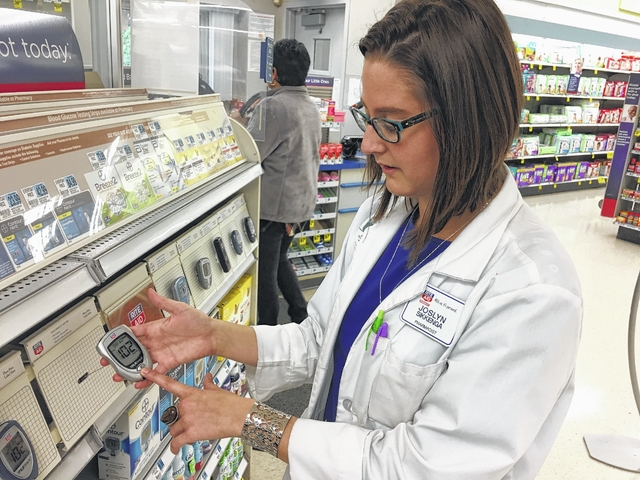ROCKINGHAM — The National Institute of Diabetes and Digestive and Kidney Diseases marks National Diabetes Month 2016 with a focus on managing the disease.
This year’s theme, “Managing Diabetes — It’s not easy, but it’s worth it,” emphasizes the importance of the role of preventative care to avert serious diabetes-related outcomes such as heart attack, stroke, kidney disease, vision loss and amputation.
According to the Centers for Disease Control and Prevention, 76,488 deaths were attributed to diabetes between 2011 and 2014, and the disease was ranked the seventh leading cause of death in the United States.
Michelle Cole specializes in diabetes management, nutrition, and eating disorders for FirstHealth of the Carolinas, and said living with diabetes requires a range of specialty care.
“Diabetes is progressive, so the longer you have it, the harder it is to control,” she said. “You want to keep your blood sugar within normal ranges. It requires a multidisciplinary team of doctors, nurses, diabetes educators and dietitians. It can also include a podiatrist and your eye care specialist. It takes a whole team off health care providers.”
Cole said management is key because diabetes affects every organ of the body.
“You have to watch your vision, kidneys, heart and blood pressure,” she explained. “All of those have to be managed and monitored.”
Asked whether heart and kidney disease are caused by diabetes or diabetes aggravates other conditions, Cole said it depends.
“If your diabetes is not controlled, it can lead to kidney damage,” she said. “It can lead to high blood pressure and high cholesterol, because diabetes is a cardiovascular disease. It’s the blood system, it’s a heart condition. It does include the heart, the arteries, the lipid levels. It all goes together. You have to manage your diet very closely.”
She explained that for most people, it’s not eating certain foods that exacerbates diabetes so much as it is overeating.
“The majority of the time, we just eat too much of everything,” Cole said. “The biggest tip is to cut out liquid sugars from our diet, because if you drink sugar in any form — soda, or even fruit juices — you’re really reducing your risk a lot (by quitting). A second tip is to just reduce portion size. Eat on a smaller plate. Don’t go back for seconds. Stop eating when you feel even the slightest bit full. We tend to eat twice as much as we need. That’s more work for your body to have to rid itself of the excessive calories.”
She added that being overweight is a marker for type 2 diabetes — which the American Diabetes Association says is the most common form of the disease. According to the Association’s website, “If you have type 2 diabetes your body does not use insulin properly. This is called insulin resistance.”
Watching portion sizes is one of several ways to help the body regulate insulin, Cole said — but once a diagnosis is made, there is no cure for diabetes.
“In my opinion, I don’t ever tell somebody they can reverse diabetes or cure it,” she explained. “It is possible to lower your hemoglobin A1C. A reading of 6.4 percent is normal. So if someone lowers theirs from 7.5, which is diabetes, to 6.4 — you are considered well-controlled, but it doesn’t go away.”
Asked whether reducing one’s intake of carbohydrates can be beneficial in regulating blood sugar levels in diabetics, Cole said yes, in some cases.
“There are some studies that promote a low-carb or a reduced-carb diet, and I am one who does tend to recommend a reduced-carb diet only because I have seen it work in so many people,” she said. “But everyone is different. There is no blanket approach to managing diabetes. In some people, their blood sugar can go too low on a low-carbohydrate diet, so it always depends on the individual. You have to take it patient by patient.”
Cole said that for most people, getting the right diabetes care is affordable.
“If you have insurance and you have a diagnosis of diabetes, most insurance covers at least 80 percent, and some 100 percent,” she said. “Medicare does. Private insurance is on an individual basis. FirstHealth has a patient assistance program, and the uninsured can apply for that and if they meet the requirements — and most people who apply do — it covers at 90 percent. It’s rare that I’ve seen anyone have to pay out-of-pocket for diabetes treatment.”
The American Diabetes Association lists the following as symptoms of diabetes:
• Urinating often
• Feeling very thirsty
• Feeling very hungry even though you are eating
• Extreme fatigue
• Blurry vision
• Cuts and bruises that are slow to heal
• Weight loss even though you are eating more (most common in type 1 diabetes), and
• Tingling, pain or numbness in the hands and feet (most common in type 2 diabetes)
The Association also warns that some people with type 2 diabetes may have “symptoms so mild that they go unnoticed.” If you suspect you may have diabetes, it is important to get tested.
Cole’s most important advice for patients in managing their disease is simple, but urgent.
“Just make sure that you have that A1C checked,” she cautioned. “If you have diabetes, that is more important even than blood sugar. That should be drawn twice a year at a minimum. Some doctors recommend it every three months for certain patients. The goal if you have diabetes is to keep that under 7 percent.”
Tuesday, Nov. 15 is the American Diabetes Association’s National Healthy Lunch Day. Learn more about diabetes and have a healthy lunch by visiting www.diabetes.org.
Reach reporter Melonie McLaurin at 910-817-2673 and follow her on Twitter @meloniemclaurin.

